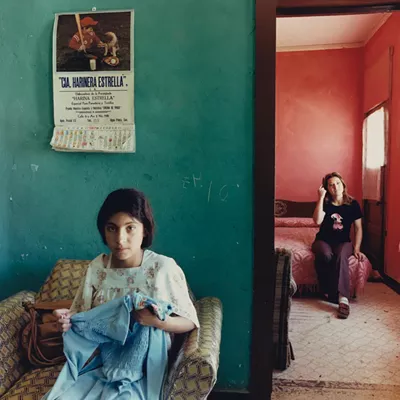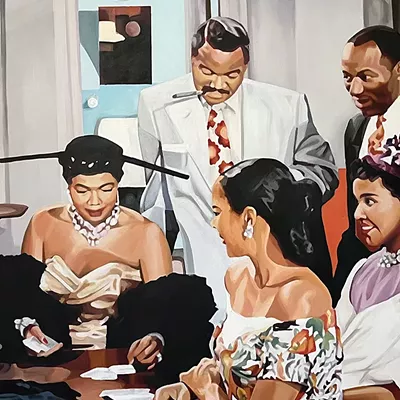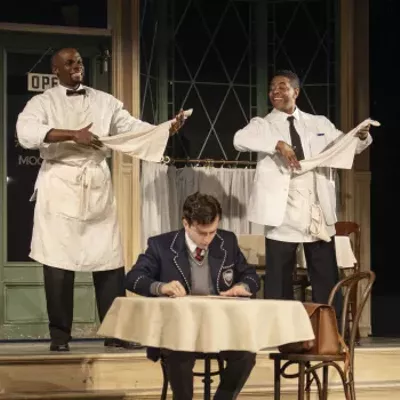It's 25 degrees outside, but "it's not cold!" dancer Timur Kinzikeev exclaims by cell phone. After all, right now in Moscow, the troupe's home base, it's 7 degrees and snowing. And in Ufa, in the Bashkortostan Republic, where Kinzikeev was born and trained, it's a mere 1 degree. Still, he adds, "I like sunny sites."
If their luck holds, Kinzikeev and the rest of the Moscow Festival Ballet dancers will get their wish for golden weather when they hit Tucson next week. On Thursday, Feb. 8, they'll perform the classical ballet Swan Lake one night only at the UA's Centennial Hall.
Kinzikeev knows a little English, most of it picked up on the troupe's multiple American tours, he says, so he's been enlisted to translate for the troupe's choreographer, Yuriy Yurovich Vetrov. Speaking through his dancer, Vetrov says that the troupe's Swan Lake, like the other works in its repertoire, is pure tradition.
"It's fully classical, with no new parts," Vetrov points out.
Set by turns in a castle and along an enchanted lake, the ballet tells a fairy tale of maidens turned into swans by an evil magician. Only true love can release them from his spell. When Prince Siegfried goes out hunting, he nearly shoots the enchanted swan princess, Odette, before falling in love with her and pledging to save her. But back at the castle, the magician's daughter, Odile, tricks Siegfried--through a sultry dance--into believing that she is Odette. He breaks his vow to the true Odette before realizing his mistake.
The swan ballerinas wear "beautiful white tutus," Vetrov says, while the evil Odile and her retinue are swathed in feathery black. Following the usual practice, a single ballerina portrays both the chaste Odette and the lascivious Odile. Three ballerinas--Olga Grigorieva, Marianna Tchemalina and Goukhar Usina--alternate the demanding part. Just two male dancers, Dmitriy Dmitriev and Ruslan Mukhambetkaliev, switch off on the less challenging role of Siegfried, he says.
Vetrov drew on the work of a variety of earlier choreographers in assembling the evening-length dance, which runs 2 1/2 hours with intermission. Now a staple of classical ballet--so much so that it's often parodied, particularly its Dance of the Little Swans, with its row of swan-women dancing with arms linked--Swan Lake went through several versions after it premiered in 1877 at the Bolshoi Theatre in Moscow.
V. Reisinger choreographed the first Swan Lake, to the now-familiar music by Tchaikovsky, and Joseph Hansen revamped it in 1880. But two later versions, an 1894 solo outing by Ivanov in 1894, and an 1895 collaboration by Ivanov and Petipa at St. Petersburg's Maryinsky Theater, are now the standard.
Vetrov relied on Ivanov and Petipa, but he's gone with a more recent version of the second act, choreographed by Yuri Grigorovich for the Bolshoi Ballet in 1969.
"I've used Grigorovich's Act II, with the Black Pas de Deux by Petipa," he explains.
The link with the Bolshoi is a natural for this company, which was founded in 1989 by former dancer Sergei Radchenko, longtime star of the Bolshoi.
Some contemporary choreographers have tampered with the Swan Lake formula in recent years. Christopher Wheeldon, the choreography wunderkind who just announced the formation of a new ballet troupe in New York City, set his version for the Pennsylvania Ballet inside a Degas painting. More famously, Matthew Bourne upended the ballet's hidebound gender politics by converting it into an all-male ballet, to critical acclaim.
Bourne's vision made for "a very interesting performance," Vetrov says. "The drama is charged. But it's quite different, a different system of ballet."
Radchenko, still the artistic director, has kept the Moscow Festival Ballet within the Russian tradition, which for more than a century has been the repository of classical ballet. Still, Vetrov says, "Ballet is not a museum. It's alive. Some companies in Russia are doing fewer classical works, and trying new forms. We have some theaters now that do classical ballet, and maybe some modern dance."
And the dancers still train in the famous Russian ballet schools, says dancer Kinzikeev, who started at age 10 at the school in Ufa.
"But my parents were in ballet," he adds. "I was born in the theater."
Kinzikeev acknowledges that the troupe's tour schedule is grueling for the dancers. They performed for two months in Germany at the end of last year, before heading to the U.S. for the four-month American tour. They began Jan. 3, and will keep dancing nearly every night through April 27.
"But we're professional dancers," he says. "That's our life."
The thought of upcoming concerts in mild Arizona, California and Florida helps keep up their spirits, he says. And so does the Russian tradition of the samovar. The dancers' contract requires every theater they visit to provide, among other alimentary provisions, "A large urn or kettle to provide a constant source of hot water for making tea."










